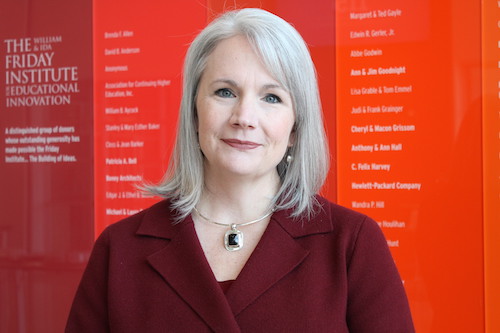Rebekah Davis

Publications
- Examining the use of Monitoring Applications in K-12 Classrooms: Perceptions of Students, Teachers, Technology Facilitators and Technology Directors , Journal of Educational Technology Systems (2025)
- Cultivating Project Resilience: Moving Through Disruption to Reimagination , SciEd Annual Conference for the National Institutes of Health (2024)
- Engaging Young Students in Unplugged CS Activities for Computational Thinking , North Carolina Technology in Education Society Conference (2024)
- Increasing educators’ self-efficacy for integrating CS concepts in the elementary classroom , International Society for Technology in Education conference (2024)
- K-12 Monitoring Applications in the Pandemic: Safety, Datafication, and the Student Experience , TechTrends (2024)
- Keeping Students Safe: Educator and Student Perspectives and Monitoring Applications Functionalities , North Carolina Technology in Education Society Conference (2024)
- Keeping Students Safe: Matching Monitoring Applications Features to Educator and Student Perspectives , International Society for Technology in Education conference (2024)
- Making CS Stick: A Model for K-5 CS Integration , Future of Education Technology Conference (2024)
- Supporting K-5 Teachers’ Integration of Computer Science in the Regular Classroom , North Carolina Technology in Education Society Conference (2024)
- Venturing into Digital Equity: Building Capacity for Reaching Across the Gaps , International Society for Technology in Education conference (2024)
Grants
The Center for Public Engagement with Science (CPES) in the UNC Institute for the Environment proposes to implement professional development that builds the capacity of secondary science teachers to incorporate timely environmental health issues and research-generated data into their teaching. The CPES will implement the proposed project, Iterative Design to Engage All (IDEA) in STEM, in partnership with environmental health researchers in the UNC Gillings School of Global Public Health and science education researchers in the UNC School of Education (SOE) and North Carolina State University College of Education. The overarching goals of this project are to improve teacher content knowledge and pedagogy associated with introducing current environmental health sciences research, positioning them to increase diverse students������������������ awareness of and interest in biomedical careers. Over five years, IDEA in STEM will engage four cohorts of teachers in long-duration professional development organized around NIH-supported research on a class of emerging contaminants known as PFAS (per- and polyfluoroalkyl substances). These chemicals are used to make a wide range of consumer products stain- and water-repellant and have been shown to harm human and animal health. According to the Agency for Toxic Substances and Disease Registry (ATSDR), the majority of people in the United States have been exposed to PFAS and have PFAS in their blood, making this a relevant environmental health issue. To bring this issue into the classroom, participating teachers will collaborate with researchers studying the health effects of PFAS to iteratively develop standards-aligned and research-based curricula and highlight biomedical career opportunities, especially those in the field of public health.
COVID-19 compelled teachers and students to shift to digital teaching and learning promoting the use of educational technology. During the pandemic, North Carolina General Assembly utilized ESSER III State reserve funds to help districts and charter schools monitor student internet activity and help identify and protect young children from related threats such as violence, self-harm, and suicide; child pornography, online predators, and sexual content; cyberbullying or other forms of online abuse; and drug or alcohol abuse. While intuition is that such monitoring software can protect children from various types of attacks, a comprehensive evaluation is still lacking on their effectiveness and the tradeoff between the protection and the sacrifice of children���s privacy. This research study brings together researchers with expertise in educational technology, cybersecurity, school counseling, and program evaluation to examine the effectiveness and impact of the use of software applications to monitor student internet activity and the use of these devices to mitigate cyberbullying and suicide prevention through the following project objectives: ��� Examine what and how monitoring applications were implemented in North Carolina districts ��� Examine the impact of the implementation of the monitoring software applications to protect students from threats and harms ��� Examine the data collected by the software, its access, and data privacy protection ��� Examine the monitoring needs of North Carolina districts and charter schools ��� Provide policy recommendations at the State and local levels
Researchers on the Program Evaluation and Educational Research (PEER) team at the Friday Institute for Educational Innovation at NC State University have extensive experience evaluating and researching digital literacy and inclusion programs across North Carolina. Additionally, we are members of the National Digital Inclusion Alliance and serve as representatives for the state���s Digital Equity and Inclusion Collaborative (DEIC). Ms. Huggins serves on the Data and Barriers working group for DEIC, which focuses on helping identify ways to deepen data collection and inventory barriers to digital equity for general and covered populations. As a result of serving within these collaboratives, we have built strong relationships with digital literacy- focused organizations leading much of the work going on in our state such as DIT, Digital Durham, the Center for Digital Equity, Kramden, E2D, the State Library, county libraries, Wake Tech, and A&T University to name a few. Our staff and graduate students also have a great deal of experience conducting literature reviews in a number of areas related to education, and would love this opportunity to explore the literature more in- depth. We are uniquely positioned as a research institute to conduct an extensive digital literacy literature review as we not only have deep experience with and knowledge of digital literacy programs and partners across the state, but we also have extensive knowledge of the data and metrics used to gauge the success of digital literacy programs.